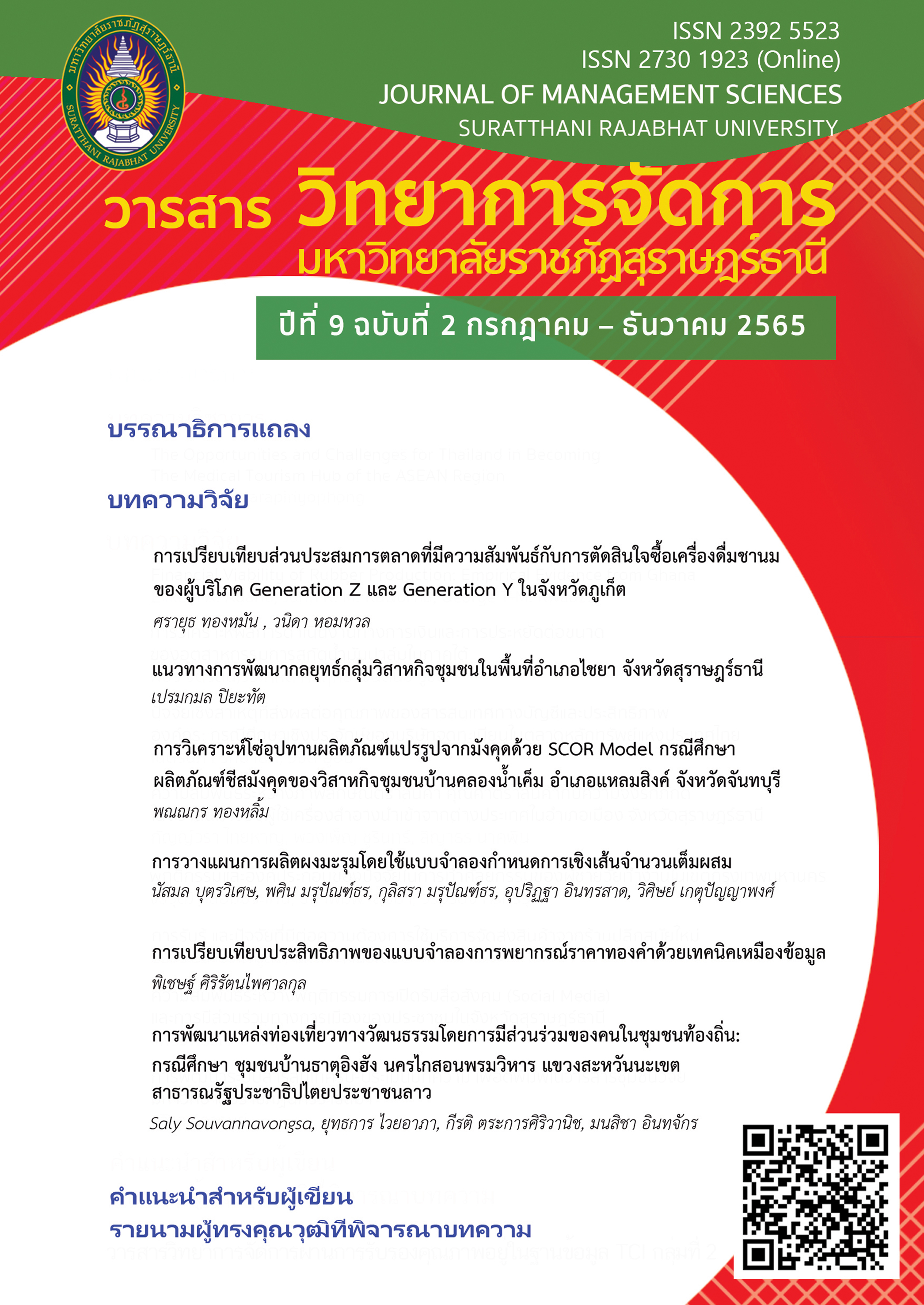การวิเคราะห์โซ่อุปทานผลิตภัณฑ์แปรรูปจากมังคุดด้วย SCOR Model กรณีศึกษาผลิตภัณฑ์ชีสมังคุดของวิสาหกิจชุมชนบ้านคลองน้ำเค็ม อำเภอแหลมสิงค์ จังหวัดจันทบุรี
Main Article Content
บทคัดย่อ
เป้าหมายของวิสาหกิจชุมชนบ้านคลองน้ำเค็ม คือ การสร้างธุรกิจให้เติบโตและยั่งยืน วัตถุประสงค์ของงานวิจัย คือ ศึกษาสภาพแวดล้อมทางธุรกิจ โครงสร้างโซ่อุปทาน และวิเคราะห์โซ่อุปทานด้วยแบบจำลองการดำเนินงานของผลิตภัณฑ์แปรรูป (ชีสมังคุด) ของวิสาหกิจชุมชนบ้านคลองน้ำเค็ม อำเภอแหลมสิงห์ จังหวัดจันทบุรี ด้วยการสัมภาษณ์เชิงลึกกับผู้ให้ข้อมูลสำคัญซึ่งเป็นประธานและสมาชิกของวิสาหกิจชุมชน ทั้งหมด 7 ราย และนำข้อมูลมาวิเคราะห์ ด้วยเครื่องมือ SWOT Analysis Supply Chain Management และ SCOR Model ตามลำดับ ผลการศึกษา พบว่า วิสาหกิจชุมชนมีจุดแข็งด้านการเข้าถึงแหล่งวัตถุดิบที่มีคุณภาพและได้รับโอกาสทางธุรกิจจากทั้งภาครัฐและเอกชน แต่ยังคงมีจุดอ่อนด้านการบริหารจัดการและพบอุปสรรคที่เกิดจากการเปลี่ยนแปลงของเทคโนโลยีและภาวะเศรษฐกิจ สำหรับโครงสร้างของโซ่อุปทาน พบว่า ธุรกิจมีการเชื่อมโยงกับหน่วยธุรกิจต้นน้ำและปลายน้ำ คือ เกษตรกรผู้ผลิตมังคุดและร้านขายของฝาก/ผู้บริโภคขั้นสุดท้าย โดยธุรกิจอยู่ในตำแหน่งกลางน้ำเมื่อวิเคราะห์เชิงลึกด้วยแบบจำลองอ้างอิง การดำเนินในโซ่อุปทาน พบว่า ธุรกิจควรพัฒนาในด้านการวางแผนให้ครอบคลุมกิจกรรมในโซ่อุปทาน โดยเฉพาะการดำเนินงานและการตลาด ซึ่งข้อจำกัดของวิจัยนี้พบว่า ธุรกิจขนาดเล็กขาดโอกาสในการเข้าถึงองค์ความรู้ที่ทันสมัยและแหล่งเงินทุน จึงเสนอให้ภาครัฐเข้ามามีบทบาทในการจับคู่ระหว่างธุรกิจขนาดเล็กและขนาดใหญ่เพื่อให้เกิดการแลกเปลี่ยนผลประโยชน์ระหว่างกัน ทั้งนี้ในงานวิจัยสามารถบ่งชี้ให้เห็นถึงจุดเริ่มต้นในการพัฒนาที่ธุรกิจควรให้ความสำคัญ โดยสะท้อนภาพรวมของปัญหาที่เกิดขึ้นในธุรกิจซึ่งช่วยมีแนวทางในการยกระดับธุรกิจที่ชัดเจนมากยิ่งขึ้นกลุ่มตัวอย่างทั้งหมด 7 ราย ประกอบด้วยประธานและสมาชิกของวิสาหกิจชุมชนบ้านคลองน้ำเค็ม ผลการศึกษา พบว่า โครงสร้างโซ่อุปทานของผลิตภัณฑ์ประกอบด้วย เกษตรกรผู้ผลิตมังคุด, ผู้รวบรวมผลผลิตมังคุด (ล้ง), วิสาหกิจชุมชนบ้านคลองน้ำเค็ม, ผู้ค้าส่ง, ร้านขายของฝาก และ ผู้บริโภคขั้นสุดท้าย นอกจากนี้วิสาหกิจชุมชนกำลังเผชิญกับสภาพแวดล้อมทางธุรกิจที่มีการเปลี่ยนแปลงอันเนื่องมาจากวิกฤติเศรษฐกิจและการเปลี่ยนแปลงของเทคโนโลยี ซึ่งในการวิเคราะห์ด้วย SCOR Model พบว่า วิสาหกิจชุมชนควรมีการวางแผนการดำเนินงานให้ครอบคลุมกิจกรรมตั้งแต่ต้นน้ำถึงปลายน้ำ เพื่อให้ทราบจุดเริ่มต้นในการปรับปรุงและพัฒนาการดำเนินงานของวิสาหกิจชุมชน ผู้วิจัยจึงเสนอแนวทางในการพัฒนาด้วยการให้ความสำคัญกับคุณภาพสินค้าเป็นอันดับ 1 คือ การพัฒนาบรรจุภัณฑ์ที่สามารถคงคุณภาพของสินค้าไว้ได้ อันดับ 2 คือ การพัฒนาแผนกลยุทธ์ทางด้านการตลาดเพื่อเข้าถึงกลุ่มลูกค้าเป้าหมายได้อย่างมีประสิทธิภาพ อันดับที่ 3 คือ การจัดการกับกระบวนการส่งคืนเพื่อรักษาความเชื่อมั่นให้กับลูกค้าเพื่อรองรับการเติบโตของธุรกิจในอนาคต
Article Details

อนุญาตภายใต้เงื่อนไข Creative Commons Attribution-NonCommercial-NoDerivatives 4.0 International License.
เอกสารอ้างอิง
Ali, I. & Aboelmaged, M. G. S. (2021). Implementation of supply chain 4.0 in the food and beverage industry: perceived drivers and barriers. International Journal of Productivity and Performance Management,4(7), 1426-1443. https://doi.org/10.1108/IJPPM-07-2020-0393
Alimo, P. K. (2021). Reducing postharvest losses of fruits and vegetables through supply chain performance evaluation: an illustration of the application of SCOR model, Journal of LogisticsSystems and Management, 38(3), 384-407. https://doi.org/10.1504/IJLSM.2020.10023883
Baimai, C. & Trongwattanawut, S. (2018). Productivity Improvement for Small Organic Rice Mills in Chiang Mai Province Using SCOR Model, RMUTT Global Business and Economics Review,13(1), 123-138.
Benzaghta, M. A., Elwalda, A., Mousa, M. M., Erkan, I. & Rahman, M. (2020). SWOT analysis applications: An integrative literature review. Journal of Global Business insight, 6(1), 55-73.
Booms, B.H. and Bitner, M.J. (1981). Marketing Strategies and Organization Structures for Service Firms. In: Marketing of Services, American Marketing Association, Chicago, 47-51.
Chantharat, M. & Maikeansarn, V. (2019). Upstream Supply Chain analysis of Sangyod Muang Phatthalung Rice Using SCOR Model, Panyapiwat Journal, 11(1), 127-138.
Delipinar, G. E. & Kocaoglu, B. (2016). Using SCOR model to gain competitive advantage: A Literature review. Procedia - Social and Behavioral Sciences, 229(2016), 398 – 406.
Department of Agricultural. (2005). Community Enterprise Promotion Act, B.E. 2548 (2005). http://web.krisdika.go.th/data/law/law2/%CA69/%CA69-20-2548-a0001.htm
Drucker, P. F., (1974). Management: tasks. Responsibilities. Practices. New York, Harper & Row.
Georgise, F.B., Wuest,T. & Wuest, K. D., (2016). SCOR model application in developing countries: challenges & requirements, Production Planning and Control. http://doi.org/10.1080/09537287.2016.1230790
Hassachu, M. & Innawong, B. (2020). A Study on analyzing the supply chain and value chain for developing the community enterprises and one Tambon one Product [Master’s thesis, Silpakorn University]. Silpakorn University Library. http://www.sure.su.ac.th/xmlui/handle/123456789/25041?attempt=2&
Jinaboon, C. (2013). Mangosteen Supply Chain Management for Export: ole of social organization and modern supply chain, MFU Connexon: Journal of Humanities and Social Sciences, 2(2), 99-122.
Kamonlimsakun, S., Watcharakiettisak, T., Kitatron, D. & Techateerapreda, S. (2017). Rice Logistics and Supply Chain Management in Nakhon Ratchasima Province: Current Situation, Relations, Problems and Development Guidelines, Suranaree Jurnal Social Science,11(2), 119-143.
Namugenyi, C., Nimmagadda, S. L., & Reiners, T. (2020). Design of a SWOT Analysis Model and its Evaluation in Diverse Digital Business Ecosystem Contexts, Procedia Computer Science, 159, 1145–1154. https://doi.org/10.1016/j.procs.2019.09.283
Nantasarn, M., Khamkula, K. & Boonsrichana, T. (2021). Development of packaging and marketing channel of Mahachanok mango Processing in commercial market at Na Chueak district Maha Sarakham province. Rajabhat Maha Sarakham University.
Nanthapodej, R., Phutthala, S. and Pattanapairoj, S. (2006). Principle of Supply Chain Operations Reference (SCOR) Model, KKU Engineering Journal, 33(4), 325- 335.
Netinant,P. (2016). Correlation of Marketing Communication Tool Exposure and Buying Behavior of “Gen Y”, Panyapiwat Journal, 8(Special Issue), 208-222.
Nongbua, B., Aungsuratana, A., & Saridnirun, P. (2017). Capability Development in Export Mangosteen Production through Supply Chain, Muang District, Chanthaburi Provincial Areas. Veridian E-Journal, 10(1), 807-821.
Office of Agricultural Economics. (2020). Mangosteen: Perennial Fruitful area, yield and yield per rai in 2020. https://www.oae.go.th/assets/portals/1/fileups/prcaidata/files/1_mangosteen2563.pdf
Ommani, A. R. (2011). Strengths, weaknesses, opportunities and threats (SWOT) analysis for farming system businesses management: Case of wheat farmers of Shadervan District, Shuster Township, Iran. African Journal of Business Management, 5(22), 9448-9454.
Paijit, P. & Thongchot, C. (2017). Management Processes Affecting Surathani Community Enterprises, Manufacturing Groups and Food Production Effectiveness, Journal of Management Sciences, 4 (2),175-204.
Phadermrod, B., Crowder, R. M. & Wills, G. B. (2016). Importance-Performance Analysis based SWOT analysis, International Journal of Information Management, 4, 194-203. http://doi.org/10.1016/j.ijinfomgt.2016.03.009
Porter, M.E. (2008). "The Five Competitive Forces That Shape Strategy." Special Issue on HBS Centennial. Harvard Business Review, 86(1), 78–93.
Samejima, M., Shimizu, Y., Akiyoshi, M., & Komoda, N. (2006). SWOT analysis support tool for verification of business strategy. IEEE International Conference on Computational Cybernetics, http://doi.org/10.1109/ICCCYB.2006.305700
Strategy and Information Group for Development of Chanthaburi Province. (2011). Report on project performance according to the action plan Government officials for the fiscal year B.E. 2562. http://www.chanthaburi.go.th/files/com_news_struct/2020-07_639d2bcbd91723e.pdf
Suwan-achariya, C., Latae, K., & Suwanmanee, N. (2018). Ways to Prevention the Shortage of Raw Materials for Processed Seafood Product, Payup University Journal, 28(2),159-171.
Thailand Development Research Institute. (2017). Logistics and Supply Chain Management of Agricultural Products Project. https://tdri.or.th/wp-content/uploads/2012/09/a148.pdf.
Thamma-apipon, S., & Sitthiphakdee, N. (2017). The Adaptability of the Mangosteen Farmers to Climate Change, Case Study: Bok-Krai Community, TambonNam-Jeut,Amphoe Kra-Buri, Ranong Province. Veridian E-Journal, 10(3), 1350-1359.
The Association for Operations Management. (2017). Supply Chain Operations Reference Model: SCOR Version 12.0. http://www.apics.org/docs/default-source/scor-training/scor-v12-0-framework-introduction.pdf?sfvrsn=2
Vorst, J. V. (2004). Supply Chain Management: theory and practices. Wageningen University. https://www.researchgate.net/publication/40122004
Yimwattana, S., Sriwilai, S., Netsawang, P., Dokmai, A. & Thaneenoppawong, T. (2021). The Development of Packaging and Branding Design for Processed Banana Products from Mueang Wiset ChaiChan, AngThong Province, Journal of Management Science Review, 23(1), 1-12.


